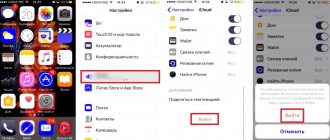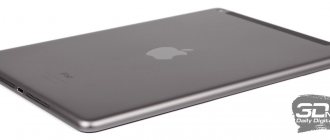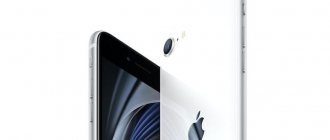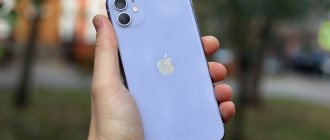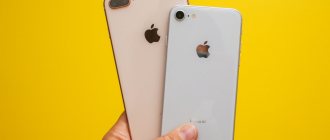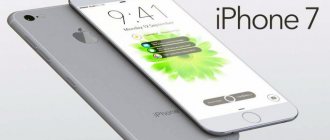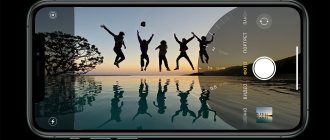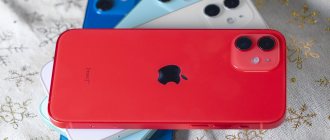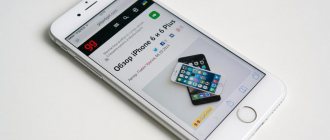The iPhone SE, released in 2016, became a real gift not only for those who are used to using a smartphone with one hand and do not want to get out of the habit, but also for connoisseurs of the classic design of Apple smartphones - the filling that was current at that time was placed in an elegant (compared to the iPhone 6) case since iPhone 4/5. Apple did a similar thing with the second generation iPhone SE - only the rollback was a little less obvious and at the same time deeper: the new SE is most similar to the iPhone 8 with its Home key and without the unibrow, but at the same time retains minimal individuality .
At the start of sales, Apple set a price of 39,990 rubles for the iPhone SE of the second version - outright pennies by the standards of the company, whose current flagships cost a hundred thousand. It is logical that at such a price Apple made a number of compromises in the filling, but they did not affect the hardware platform: it uses the same A13 Bionic system as in the iPhone 11/11 Pro - so worry that the baby will “turn into a pumpkin "faster than current older models is not worth it. Simplifications have affected the rear camera (a single module without night mode is used here), the front camera (a well-deserved, but outdated 7 megapixel module), the user identification system (the return of the fingerprint scanner in the Home key instead of Face ID), the screen matrix (IPS instead of OLED ) and the amount of RAM (3 GB). Apple, in fact, did not even release a replacement for the iPhone Xr, which had fewer compromises compared to the iPhone Xs, but a direct alternative to the Google Pixel 3a. Let's see how meaningful and competitive the new Apple iPhone SE turns out to be.
⇡#Technical characteristics
| Apple iPhone SE (2020) | Apple iPhone 11 | Sony Xperia 5 | Google Pixel 3a | Huawei P40 | |
| Display | 4.7 inches, IPS, 1334 × 750 pixels, 326 ppi, capacitive multi-touch | 6.1 inches, IPS, 1792 × 828 pixels, 326 ppi, capacitive multi-touch | 6.1 inches, OLED, 2520 × 1080 pixels (21:9), 449 ppi, capacitive multi-touch | 5.6 inches, OLED, 2220 × 1080 pixels, 441 ppi, capacitive multi-touch | 6.1 inches, OLED, 2340 × 1080 pixels, 422 ppi, capacitive multi-touch |
| Protective glass | No information | No information | Corning Gorilla Glass 6 | Asahi Dragontrail Glass | No information |
| CPU | Apple A13 Bionic: six cores (2 × Lightning, 2.65 GHz + 4 × Thunder, 1.8 GHz) | Apple A13 Bionic: six cores (2 × Lightning, 2.65 GHz + 4 × Thunder, 1.8 GHz) | Qualcomm Snapdragon 855: eight cores (1 × Kryo 485 Gold, 2.84 GHz + 3 × Kryo 485 Gold, 2.42 GHz + 4 × Kryo 485 Silver, 1.78 GHz | Qualcomm Snapdragon 670: two Kryo 360 Gold cores, 2.0 GHz + six Kryo 360 Silver cores, 1.7 GHz | HiSilicon Kirin 990 5G: eight cores (2 × ARM Cortex-A76, frequency 2.86 GHz + 2 × ARM Cortex-A76, frequency 2.36 GHz + 4 × ARM Cortex-A55, frequency 1.95 GHz); HiAI architecture; 5G modem |
| Graphics controller | Apple GPU (4 cores) | Apple GPU (4 cores) | Adreno 640 | Adreno 615, 700 MHz | ARM Mali-G76 MP16 |
| RAM | 3 GB | 4 GB | 6 GB | 4 GB | 6/8 GB |
| Flash memory | 64/128/256 GB | 64/128/256 GB | 128 GB | 64 GB | 128/256 GB |
| Memory card support | No | No | Yes (microSD up to 1 TB) | No | Yes (Huawei nanoSD only) |
| Connectors | Lightning | Lightning | USB Type-C | USB Type-C, 3.5 mm | USB Type-C |
| SIM cards | One nano-SIM and one eSIM | One nano-SIM and one eSIM | Two nano-SIMs | One nano-SIM | Two nano-SIMs |
| Cellular connection 2G | GSM 850/900/1800/1900 MHz CDMA 800/1900 MHz | GSM 850/900/1800/1900 MHz CDMA 800/1900 MHz | GSM 850/900/1800/1900 MHz | GSM 850/900/1800/1900 MHz | GSM 850/900/1800/1900 MHz |
| Cellular 3G | HSDPA 850 / 900 / 1700 / 1900 / 2100 MHz CDMA 2000 MHz | HSDPA 850 / 900 / 1700 / 1900 / 2100 MHz CDMA 2000 MHz | HSDPA 800 / 850 / 900 / 1700 / 1900 / 2100 MHz | HSDPA 850 / 900 / 1700 / 1900 / 2100 MHz CDMA 2000 MHz | HSDPA 800 / 850 / 900 / 1700 / 1900 / 2100 MHz |
| Cellular 4G | LTE-A Cat.16 (up to 1024/150 Mbit/s), bands 1, 2, 3, 4, 5, 7, 8, 11, 12, 13, 17, 18, 19, 20, 21, 25, 26 , 28, 29, 30, 32, 66 | LTE-A Cat.16 (up to 1024/150 Mbit/s), bands 1, 2, 3, 4, 5, 7, 8, 11, 12, 13, 17, 18, 19, 20, 21, 25, 26 , 28, 29, 30, 32, 34, 38, 39, 40, 41, 42, 46, 48, 66 | LTE Cat. 19 (up to 1600/150 Mbit/s), bands 1, 2, 3, 4, 5, 7, 8, 12, 17, 18, 19, 20, 26, 34, 38, 39, 40, 41 | LTE Cat. 11 (600 Mbps): 1, 2, 3, 4, 5, 7, 8, 12, 13, 17, 20, 25, 26, 28, 32, 38, 40, 41, 66 | LTE: bands 1, 2, 3, 4, 5, 6, 7, 8, 9, 12, 17, 18, 19, 20, 26, 28, 32, 34, 38, 39, 40, 41 |
| WiFi | 802.11a/b/g/n/ac/ax | 802.11a/b/g/n/ac/ax | 802.11a/b/g/n/ac | 802.11a/b/g/n/ac | 802.11a/b/g/n/ac/ax |
| Bluetooth | 5.0 | 5.0 | 5.0 | 5.0 | 5.1 |
| NFC | Yes (Apple Pay) | Yes (Apple Pay) | Eat | Eat | Eat |
| Navigation | GPS, A-GPS, GLONASS | GPS, A-GPS, GLONASS, Galileo, QZSS | GPS (dual band), A-GPS, GLONASS, BeiDou, Galileo | GPS, A-GPS, GLONASS, Galileo | GPS (dual band), A-GPS, GLONASS, BeiDou, Galileo, QZSS, NavIC |
| Sensors | Illumination, proximity, accelerometer/gyroscope, magnetometer (digital compass), barometer | Light, proximity, accelerometer/gyroscope, magnetometer (digital compass), barometer, Face ID | Light, proximity, accelerometer/gyroscope, barometer, magnetometer (digital compass), color spectrum sensor | Illumination, proximity, accelerometer/gyroscope, magnetometer (digital compass), barometer | Light, proximity, accelerometer/gyroscope, magnetometer (digital compass), Face ID |
| Fingerprint's scanner | Yes, in the Home key | No | Yes, on the right side | Eat | Yes, on the screen |
| Main camera | 12 MP, ƒ/1.8, quad LED flash, phase detection autofocus, optical stabilization | Dual module, 12 + 12 MP, ƒ/1.8 + ƒ/2.4, dual LED flash, phase detection autofocus and five-axis optical stabilization - in the main module | Triple module, 12 + 12 + 12 MP, ƒ/1.6 + ƒ/2.4 + ƒ/2.4, phase detection autofocus, LED flash, five-axis optical stabilization in the main and TV modules | 12.2 MP, ƒ/1.8, phase detection autofocus, dual LED flash, optical stabilization | Triple module, 50 + 8 + 16 MP, ƒ/1.9 + ƒ/2.4 + ƒ/2.2, phase detection autofocus, optical stabilizer, dual LED flash |
| Front-camera | 7 MP, ƒ/2.2, no autofocus, no flash | 12 MP, ƒ/2.2, no autofocus, no flash | 8 MP, ƒ/2.0, fixed focus, no flash | 8 MP, ƒ/2.0, fixed focus | Dual module: 32 MP, ƒ/2.2 + TOF camera, fixed focus, no flash |
| Nutrition | Non-removable battery: 6.96 Wh (1821 mAh, 3.8 V) | Non-removable battery: 11.91 Wh (3110 mAh, 3.8 V) | Non-removable battery: 11.92 Wh (3140 mAh, 3.8 V) | Non-removable 11.4 Wh battery (3000 mAh, 3.8 V) | Non-removable battery: 14.44 Wh (3800 mAh, 3.8 V) |
| Size | 138.4 × 67.3 × 7.3 mm | 150.9 × 75.7 × 8.3 mm | 158 × 68 × 8.2 mm | 151.3 × 70.1 × 8.2 mm | 148.9 × 71.1 × 8.5 mm |
| Weight | 148 grams | 194 grams | 164 grams | 147 grams | 175 grams |
| Housing protection | IP67 | IP68 | IP65/IP68 | No | IP53 |
| operating system | iOS 13 | iOS 13 | Android 9.0 Pie | Android 9.0 Pie | Android 10, EMUI 10 shell |
| Current price | 39,990 rubles for the 64 GB version, 44,990 rubles for the 128 GB version, 53,990 rubles for the 256 GB version | 56,525 rubles for the 64 GB version, 62,525 rubles for the 128 GB version, 71,890 rubles for the 256 GB version | 47,800 rubles | 37,990 rubles | 44,990 rubles |
| Information on technical characteristics and subsystems of Apple iPhone SE (2020) | ||||||
Design, ergonomics and software
In terms of the appearance of the iPhone SE (2020), as I said above, the designers took inspiration from the 6th-8th generation iPhones: healthy frames around a small screen, a round key below it, rounded and thin edges. You can distinguish the new SE from the G8 by paying attention to the location of the apple on the rear panel - here it is in the center. Not too much, right? But costs have been reduced - there is no need to redesign the production of cases for the new product: we leave the iPhone 8 assembly line, just change the engraving. Apple has always been famous for its extreme restraint in matters of design changes and at the same time its desire to maintain the high margins of its products - and it does not betray itself in the new SE.
Such a smartphone looks somewhat archaic in 2022 - I wouldn’t call myself a fan of “cutouts” and “holes,” but to decide to release a gadget with such healthy bezels around the screen (even larger than those of its direct competitor, Google Pixel 3a), you need be... Apple. The fans of this company will understand everything and forgive everything. However, it’s actually not difficult to forgive - thanks to the use of a 4.7-inch screen, even with such frames, the smartphone turned out to be miniature and extremely light. I forgot the last time I experienced these sensations - when you don’t notice the phone in your pocket. Before going out, you pat your pockets several times - it’s very difficult to get rid of the feeling that you forgot your phone at home. I recently wrote about the compact (I could barely resist the quotes) Huawei P40, but this, of course, is on a completely different level. Today you can find a current smartphone with smaller dimensions - but it will be extreme, like the Palm PVG100. So if you are looking for real compactness, then this is the place for you - even Sony has stopped producing such miniature tubes; The Xperia 5 deserves a mention, but it is also noticeably larger.
Apple iPhone SE (2020), front panel: above the screen - earpiece, light sensor and front camera; below the screen is the Home key with a built-in fingerprint scanner
The Apple iPhone SE (2020) comes in three colors: black, white and red - all quite boring, but popular. The sides are made of aluminum, and the back of the smartphone is covered with glossy glass - easily soiled, but not very slippery: the device holds well in the hand due to its size, and does not slide off different surfaces, because the back is flat and not curved at the edges. Nevertheless, it’s better to put the gadget in a case out of harm’s way. However, you will have to buy it separately - Apple never includes it in the kit.
Apple iPhone SE (2020), rear panel: in the corner - single main camera, microphone and flash
The experience of using the iPhone SE (2020) is mixed: on the one hand, I have long been unaccustomed to screens of such a small diagonal, on the other hand, this is a smartphone that is easy to “steer” with one hand! Well, in general, it takes you back to the times of human-sized gadgets. Those were good times, I must say, although not so “smartphone-centric.”
Apple iPhone SE (2020), left side: volume keys/camera shutter release and sound profile switcher
Apple iPhone SE (2020), right side: gadget power/lock key and SIM card slot
The functional elements are in place - almost nothing changes here from iPhone to iPhone: the power key on the right side, the volume keys and the sound profile switching lever on the left. The touch Home key sings its swan song below the screen. There is plenty of space above the screen - all the sensors necessary for Face ID would fit, and even a multi-camera system! But no, only a tiny seven-megapixel front camera lens, a sensor and a speaker.
Apple iPhone SE (2020), the top edge is free of functional elements
Apple iPhone SE (2020), bottom edge: Lightning port, microphone and main speaker
There is no mini-jack - he disappeared on the "seven" and is unlikely to ever return. The dust and moisture protection class of the case is IP67: you can swim, but without much effort. Unfortunately, we haven’t seen a USB Type-C connector yet. But the hope that Apple will nevertheless meet the aspirations of the masses does not leave us - someday the times of universal unification will come. Someday, but not now.
The fingerprint scanner is built into the Home key. The good old capacitive sensor of human size, but not in the best place - it is still more convenient when it is located closer to the center of the smartphone, built into the display “sandwich”, as in modern flagships, or on the back panel under the index finger. You have to grab the gadget in your hand, there is a risk of dropping it at this moment. The sensor itself is good - it responds instantly, the error rate is minimal. There is no facial recognition system - the manufacturer did not install Face ID here (probably for reasons of status or simply as unnecessary), and Apple rightly refrained from a duplicate system based on a regular front camera - the level of protection of user data is insufficient.
Screenshot gallery
View all images (16)The new iPhone SE (2020) runs the iOS 13 operating system, which we wrote about in detail in our review of the iPhone 11 Pro Max. Version iOS 13.4 differs little from the one we talked about in the autumn material - here we would mention the Deep Fusion system, which improves pictures, but the new SE did not get it: the processor necessary for this is here (the same Apple A13 Bionic platform ), but does not have the required camera.
He is flying. Because inside there is a “flagship”
I have an iPhone 5s next to me for comparison. So, the difference is cosmic. My colleague Mikk described it best:
After the iPhone SE, the “old” iPhone 5s seems like a Chinese fake on crooked Android.
It turns out that desktop animation, including the search bar, may not slow down. All menus open without a single hint of lag. Applications fly, no “thoughtful” screens.
The difference is obvious. You don’t need to look at the back panel to see which of the “fives” is new: you just take it, unlock it and understand everything without unnecessary movements.
2 gigabytes of RAM do the job. I predict the iPhone SE will have a life cycle of 3-5 years without any major problems for the owner. Give this deadline to current iPhone 6 users and you will hear sobbing and crunching in response.
⇡#Display and sound
Apple did not split hairs and put on the iPhone SE (2020) a display from the iPhone 8 (and if you dig deeper, then maybe from the iPhone 6) - or at least extremely close to it in terms of characteristics. This is a 4.7-inch diagonal IPS LCD screen with a resolution of 750 × 1334 pixels. The pixel density is 326 ppi – it fits into the Retina standard. In this case, to be honest, I don’t want to demand more. There's no need to display a 4K image on a small display, and fonts and applications look good and smooth at this pixel density on a screen of this size.
There is a polarizing layer, an oleophobic coating and other similar joys of 21st century gadgets, but there is no talk of the screen’s compliance with the HDR standard and support for the DCI-P3 color profile (there is only nominal support for HDR10 and Dolby Vision for video files) - this is a display from about 2014- th. The viewing angles are wide, and it is configured flawlessly, traditionally for Apple - more on this below.
But I used the word “approximately” in the paragraph above for a reason. In terms of brightness and contrast, this panel is far superior to the one we tested on the iPhone 8. The brightness indicator is absolutely remarkable - 595 cd/m2, quite at the level of the current flagship with an IPS matrix, iPhone 11. The contrast level for a mobile LCD screen is good - 1544:1. Progress compared to iPhone 8 is noticeable to the naked eye. But the very fact of using an LCD screen in a smartphone costing 40 thousand rubles today already looks like either a front or excessive savings - it was simply impossible to find direct competitors for comparison; you won’t find LCD screens on smartphones priced above 25 thousand rubles these days.
The display settings are typical for an iPhone - you can’t manually adjust the color rendition, you can only turn on/off the True Tone mode for automatically adjusting colors to ambient lighting, select a light or dark shell theme, activate the night mode and “play with fonts.” I measured the color rendering of the display both with True Tone enabled and without it - however, in the first case, the measurement results can be considered more or less conditional.
Apple iPhone SE (2020), gamma. Yellow line – iPhone SE (2020) indicators, dotted line – reference gamma
Apple iPhone SE (2020), color temperature. Blue line – iPhone SE (2020) indicators, dotted line – reference temperature
Apple iPhone SE (2020), color gamut. Gray triangle – sRGB coverage, white triangle – iPhone SE (2020) coverage
In Default mode, iPhone SE (2020) confidently meets Rec. 709. The color gamut is almost identical to the sRGB space. The average gamma is close to ideal - 2.26, the curves are stable. The color temperature line is absolutely flat, but the colors are slightly cooler than the reference - closer to 7,000 K compared to the reference of 6,500 K. The average DeltaE deviation on the Color Checker scale, which includes both a wide range of colors and shades of gray, is 2.31, which falls within the normal range.
Apple iPhone SE (2020), gamma with True Tone mode enabled. Yellow line – iPhone SE (2020) indicators, dotted line – reference gamma
Apple iPhone SE (2020), color temperature with True Tone mode enabled. Blue line – iPhone SE (2020) indicators, dotted line – reference temperature
Apple iPhone SE (2020), color gamut with True Tone mode enabled. Gray triangle – sRGB coverage, white triangle – iPhone SE (2020) coverage
When True Tone is activated, the picture noticeably changes visually - it becomes noticeably warmer. I am used to writing in this place “what is more pleasing to the eye,” but this is not entirely true - the image is indeed more honest, but for many people it is just the cold picture that is more pleasant. I took measurements in dim natural light in the evening of a cloudy day - in this case, the color temperature dropped below 6,500 K, the gamma curves became slightly feverish, although the average values remained at the same level (2.28). The average deviation Delta E on the Color Checker scale is already outside the norm - 3.33. The screen, although technologically imperfect by today's standards, is set up perfectly.
Apple iPhone SE (2020), as usual, lacks a mini-jack - and the manufacturer even stopped including adapters from Lightning to 3.5 mm in the kit. In terms of wireless sound quality, this iPhone, as well as all others, cannot be faulted - although connecting headphones, if they are not AirPods, can be quite difficult. For my Sony WH-1000XM3 I had to install a special application. The speakers are stereophonic, along with the speaker located on the bottom edge that works in the front plane. They sound good, and talking using the iPhone SE (2020) is also quite comfortable.
The design is not outdated. I missed.
All iPhones in the “five” case look like jewelry. Jonathan Ive spoke directly about this at one time: they say, we made this case, trying to give it the features of precious jewelry.
Gold does not age, just like silver. This aluminum brick doesn't feel thick or uncomfortable. It just digs into your hand a little - an unusual sensation after 2 years of owning a “six”.
But when you put both on the table, you instinctively think: after all, the SE looks more expensive . Not more expensive, like a gadget, like a “sophisticated thing” - but more expensive, like a good thing.
It is clear that all these are purely visual moments, and the design of the “six” is still awesome. But there is no jewelry magic in it. It's a matter of SE.
⇡#Hardware and performance
The Apple iPhone SE (2020) is chock-full of compromises, but not in terms of the hardware platform - and this is exactly the best news for owners of the previous “mini iPhone”. For relatively reasonable money, you can now buy a smartphone of relatively reasonable size with extremely up-to-date hardware, which will not suffer in performance (and battery life, as is customary with Apple) for another four years. This is largely why everything was started: the iPhone SE (2020) is no longer aimed at a new audience, but at adherents of the past SE, which has managed to grow old since its release and completely lose relevance.
The Apple A13 Bionic platform consists of six processor cores (2 × Lightning + 4 × Thunder), the clock speed of which is not specified, an Apple GPU graphics subsystem with four cores and a third-generation Neural Engine system (used for operations with neural networks). The platform is manufactured by TSMC using a 7-nanometer process technology.
Thanks to the perfect optimization of the operating system and programs for it, the Apple A13 Bionic shows excellent results in all synthetic tests, ahead of last year's flagship Qualcomm Snapdragon 855 platform and competing on equal terms with the current Snapdragon 865. But there are some concerns about throttling - the iPhone SE (2020) gets very hot under heavy loads. I didn’t notice any noticeable drop in frame rate in resource-intensive games, and I couldn’t find benchmarks on iOS to check this indicator - so my concerns will remain concerns, and I cannot confirm them with documentation.
The overall impressions of the speed and compatibility of the iPhone SE (2020) with any, even the most demanding applications from the AppStore are the best. Here the new SE is no different from the iPhone 11 Pro. The small amount of RAM (only 3 GB) should not be a problem today due to the low display resolution, but it may become a problem in the future. However, I don’t think that this future will come earlier than in 3-4 years.
Apple iPhone SE (2020) can be bought with 64, 128 or 256 GB of internal memory - of course, there is no way to expand this volume. Despite the price attractiveness of the 64 GB version, I do not recommend it - the drive will fill up in a matter of months, and you will have to pay for iCloud.
He is very small. Whoa.
As a 6s Plus owner, I'm shocked. What a miniature keyboard, it's just a kickass. How to print on it? Although…
You can’t fool muscle memory; in the end, I never missed a beat while I was entering personal data with the initial settings. The screen, by the way, due to its size seems clearer than that on the sixes.
I've been using it for about 20 minutes at the time of writing these lines. So I pick up Plus and think. Still, it was good when there were no shovels. But for two years now we have no choice; if you want a “top” smart, you have to take a huge one.
Thank you, Apple - now you have a choice.
⇡#Communications and wireless communications
In terms of communication capabilities, the iPhone SE (2020) fully complies with the standards adopted by Apple today: support for dual-SIM mode with the condition that one of the two SIM cards will be electronic, LTE category 16 (data reception speed in theory reaches gigabit per second) with a normal list of bands and lack of a 5G modem - Apple, as always, is in no hurry.
Apple iPhone SE (2020), slot for a single nano-SIM card
Other wireless modules: Wi-Fi 802.11a/b/g/n/ac/ax (with support for Wi-Fi 6), Bluetooth 5.0 and NFC, which is used for contactless payment via Apple Pay. The navigation system works with GPS (A-GPS) and GLONASS.
iPhone SE in Moscow. Five impressions
Nikita: taking the French speaker from Arthur while unboxing my own iPhone SE.
He came to me literally 10 minutes ago, so I quickly finish writing these lines and go to test.
I want to say right away that this phone is not intended for those who fall for gold 12-inch MacBooks, buy 100,500 dull Apple Watch straps and generally buy Apple just because it’s fashionable.
This smart is for those who remember what Apple was like under Jobs. No shovels, Samsung killers. Just a really convenient smartphone that can do absolutely everything.
My five first impressions follow.
⇡#Camera
Perhaps the biggest compromise on the iPhone SE (2020) is the camera. Again, you can look back at the Google Pixel 3a, you can refer to the previous iPhone SE, compared to which there is obvious progress, but in general the tactic of starting from the laggards and ignoring the world around Apple products looks quite counterproductive. Let’s just state: the SE has a single camera from 2022, and this solution can hardly be considered truly progressive.
The lens protruding slightly above the body has an aperture of ƒ/1.8 and a focal length equivalent to 28 mm, and a 12-megapixel sensor with an optical stabilizer and phase detection autofocus is hidden deeper. Next to it is a traditional iPhone flash with four True Tone LEDs. All improvements regarding the iPhone 8 relate exclusively to software.
| A couple of examples of night shooting on iPhone SE (2020) | ||
At the same time, I repeat, there is no support for Deep Fusion, despite the presence of a built-in AI accelerator. Everything is simpler: the iPhone SE (2020) camera can stitch HDR (Smart HDR, of course), and you cannot somehow control its actions - but you can turn it off, for which you will have to go into the general settings. Classic: the iPhone decides everything for you, the maximum allowed is to slightly correct the exposure. You can’t even focus manually, so that, for example, you can focus on the droplets on the glass and not what’s behind the glass. Shooting in RAW is also not supported.
But there is a portrait mode, despite the lack of a camera specifically designed for this. Its capabilities are limited due to the wide angle of the optics - you can’t really take close-ups, the spatial distortions are too great. But both in terms of background blur and in terms of effects (both light and the virtual aperture that can be changed after the fact), the iPhone SE (2020) is not much inferior to its multi-camera counterparts.
In general, in terms of shooting quality, the new iPhone SE manifests itself exactly as you would expect from it: pleasant color rendition, decent dynamic range and overall high image quality for scenes shot with good lighting, on the one hand, and on the other hand, poor shooting capabilities In the dark. I wouldn’t say that the SE can’t handle evening scenes at all - after all, there is an optical stabilizer here, and the “brains” somehow help cope with noise, but the situation is not the same with its competitors, who all have one or another multi-frame stitching system noticeably better. For users of the previous iPhone SE, the progress will be obvious, but for owners of the iPhone 8, for example, it will not be so much. I don’t even want to talk about the lack of zoom and widening of the viewing angle.
Gallery of pictures
View all images (28)In terms of video, everything is not bad: Apple iPhone SE (2020) records 4K video at up to 60 frames per second, stabilization works at any resolution and at any frequency, HDR at up to 30 frames per second. The picture is smooth, clear, with a very smooth transition along the frame border, without rolling shutter. When it comes to video processing, the iPhone can still give almost all its Android competitors a run for their money. But again, there is no optical zoom, and slow motion is a maximum of 240 frames per second at Full HD resolution. However, it’s impossible to make a complaint about the new SE based on video - it’s a good modern level.
The front camera also came from the iPhone 8: 7 megapixels, ƒ/2.2, no autofocus, no flash. But again, there is a portrait mode with proprietary effects, and the image quality has improved somewhat since then - processing algorithms do not stand still.
It's like he's weightless.
I usually carry the 6s Plus with the branded silicone case. So, I picked up the SE now and realized how heavy the shovel is compared to the new product.
It's like comparing a fluff of potatoes and a kilogram of potatoes . Yes, you can carry a potato all day without problems, but if it weighed like a feather, no one would be upset.
The difference between the iPhone SE and 6s Plus (in the case) is exactly twofold. But at the same time, the SE can do everything the 6s can. As they said in a famous advertisement, if the result is the same, why carry more?
⇡#Autonomous operation and charging
In my opinion, the main weak point of the iPhone SE (2020) is not the camera (it’s unlikely that the target audience of this smartphone really dreams of the best shooting quality in the world), but autonomy. Suspicions creep in even when looking at the figure - the new SE has a battery with a capacity of 6.96 Wh (1821 mAh, 3.8 V). We haven’t seen such numbers even for iPhones for a long time. But here is a small screen and the signature efficiency of software processes, right?.. Yes, probably true, but this is no longer enough - modern tasks and a powerful hardware platform also require a lot of energy, which can no longer be compensated for by a small screen alone. Plus, we're talking about an LCD display, not an OLED, so a dark theme won't help much either. As a result, the smartphone “lives” under ordinary usage scenarios (not at maximum screen brightness, with True Tone enabled) from 9 to 13 hours, and under extreme load it gives up in 5-6 hours. The most telling moment was when activating the Antutu benchmark - the smartphone needed exactly 10% of its charge to cope with this task. To say that this is weak autonomy means to significantly embellish the reality.
In our traditional test with Full HD video playback, with notifications turned on and connected to a Wi-Fi network, the iPhone SE (2020) showed an expectedly mediocre result - around seven hours.
Apple in its presentation talked about an 18W charger that will charge the new SE by 50% in half an hour. It was easy to believe - a battery of such capacity can be fully charged in half an hour with the proper power. The usual thing for Cupertinos intervened - they, of course, did not include this charger in the kit, limiting themselves to a 5-watt one. With its help, a smartphone (with a battery capacity of less than 2000 milliamp-hours, let me remind you) is charged in about two hours. This is not serious. Wireless charging, by the way, is supported, but a special adapter for it, of course, will also have to be purchased separately.
My final opinion
This is the number one smartphone for those who stopped believing in Apple and stayed at the “A” level. The rest will begin to think the same way when they hold it in their hands - and with nostalgia they will remember how convenient it was just recently.
The iPhone SE can be taken simply because it represents the best that the Cupertino team has achieved over the years. Breakthroughs in hardware, metal in the body, stylish and slightly “elite” design.
Yes, lovers of fashionable new spillikins will not fall for him. They won't be able to show off for another social media celebrity. You won’t flaunt them at every turn, showing that you are “a fashionable person with a new Apple product.”
Because this smart is for those who are in the know . He wiped away a tear and went to use it. Good luck to all.
⇡#Packaging, delivery set
The package contents of any version of the iPhone have not changed since issue 5. It includes Ear Pods, a 1m Lightning cable, and a 5W power adapter. To charge your phone faster, you can also use the 12-watt adapter from the iPad. The only peculiarity: the iPhone SE comes with a bent wire clip for removing the SIM card, and not a solid one made of amorphous material, as in more expensive models.
The range of branded cases has been updated, which includes new colors that go well with the pink case.
Notes
Cocoa Touch Core Animation FaceTime iOS (version history) iTunes SDK VoiceOver WebKit Applications iBooks · iMovie · iPod · Mail · Maps · Safari (version history) · Spotlight · SpringBoard · YouTube · Siri Services App Store · Game Center · iAd · iBookstore · iTunes Store · MobileMe · Push Technology Accessories iPhone 4 Bumper · Dock connector · Apple earbuds · EarPods · Lightning See also: 300-page iPhone billen · FairPlay · History · iFunden · Jailbreak · Recycling iPhoneen
